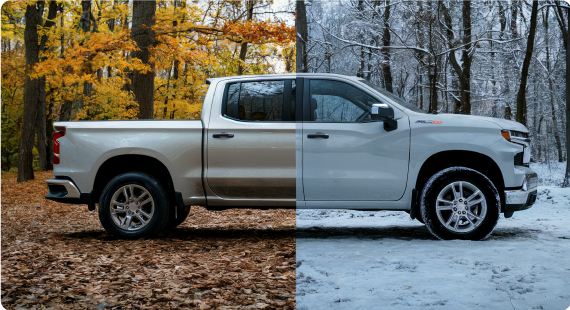Buy Winter Tires at City Buick Chevrolet GMC in Toronto
As the weather gets colder, it's time to prepare for winter by switching out your summer or all-season tires for winter tires. Whether you need to buy a new set, have them installed, or store your current tires, we can help with all your tire needs.
| Days | Hours |
| Monday | 7:00AM to 5:00PM |
| Tuesday | 7:00AM to 5:00PM |
| Wednesday | 7:00AM to 5:00PM |
| Thursday | 7:00AM to 5:00PM |
| Friday | 7:00AM to 5:00PM |
| Saturday | 7:30AM to 1:00PM |
| Sunday | Closed |

Winter is coming, and it’s time to get your car ready for the snowy roads of Toronto. If you need to buy a new set of winter tires, get them installed, or store your all-season tires, we can help! Whether you have a GM vehicle or a different brand, a small car or a full size truck, we have great tires in your price range. Click here to learn more!
Why Buy Winter Tires?
Not sure what kind or size of tires, rims or wheels your vehicle needs? We answered the most common questions we get asked by our customers here so you can find the information you need. If you have a question that isn’t answered, you can contact us at our parts department at any time! We’re experts at dealing with the common issues that winters tires have driving in the Toronto area.
How does the winter tire insurance discount work?
As of January 1st, 2016, Ontario Law requires that all Car Insurance companies offer discounts to drivers who use winter tires. How it works depends on which insurance company you are with, as some will offer a discount based on your entire policy but others may give the discount the collision coverage portion. However, in general the winter tire insurance discount comes to around 3 to 5 percent of your policy. If you want to find out the details for your policy, contact your insurance provider for more details!
Is it better to have my winter tires on their own rims?
When you have two sets of tires for the colder and warmer seasons of the year, you can either have each set of tires on their own rims or have the tires themselves switched on and off the same rims. The main reason to use just one set of rims is because it is cheaper up front to buy new tires without rims. However, those initial savings you have up front are wiped out over time by other costs down the line:
- Having separate rims for your winter tires helps extend the lifespan of the rims for your summer or all-season tires from the ice, snow, heavily salted roads during Toronto’s winters
- It costs less to change tires with their own rims than it is to swap the tires between the same set of rims
- Changing the tires on the same rims will wear both the tires and rims quicker
If you want to save on buying rims for your winter tires, you can look for a regular steel rim instead of an alloy set. That’s one of the reasons why you commonly see cars with different looking wheels in the winter.
How can I find out the right tire size for my car?
For people who are new to owning a car, or buying a new set of tires for the first time, it can be a bit confusing to find out the right size to buy that fits your vehicle. Cars, trucks, vans and SUVs all come with different sizes, and so they require different widths, profile height, and rim diameter. When shopping for tires you will see something like this: P195/65R/15. That represents a type of code that will tell you everything you need to know about what size tire to get. Here’s how that breaks down:
- P = indicates the tire you need is for a passenger car. You can also find tire ratings with LT (for light truck), T (temporary, for spare tires) or ST (special trailer)
- 195 = the width of the tires you need, measured in milometers from the inner sidewall to the outer sidewall
- 65 = the number indicates the aspect ratio, or profile height, of the tire, which is determined by dividing the height of the tire from the rim by the width. In this case, 65R means that the tire’s height is 65% of the width
- R = The letter represents the type of internal construction of the tire. It means the
- D = This letter mean diagonal or bias ply construction, but they are mostly used for heavy-duty vehicles for things like agriculture
- 15 = the last number represents the diameter measured in inches for the rim that the tire can be mounted on
The next question you’re probably asking is how you can find out all of that information? There are a number of potential locations where you can look up the tire size code for your vehicle:
- The inside of the driver’s door — look for a sticker that lists vehicle capacity weight, seating capacity, tire pressure, and tire size.
- The inside of your gas hatch or glove box — not many cars will have a sticker in these locations, but some do
- Your owner’s manual — will either tell you where to find the sticker or tell you the tire size code
- The sidewall of your current tires
If you have any problems or questions about how to find the right tire size for your vehicle, you can always call us or bring your vehicle in for help!





